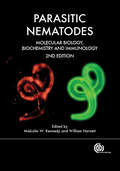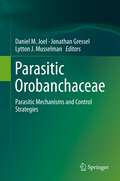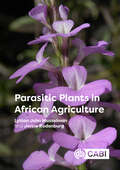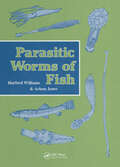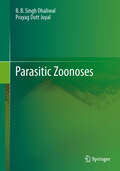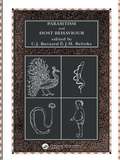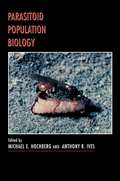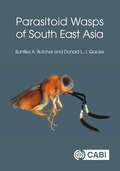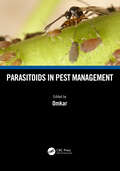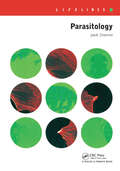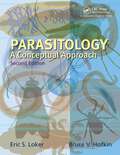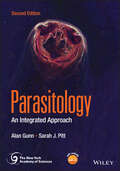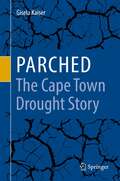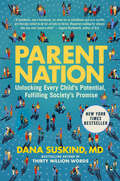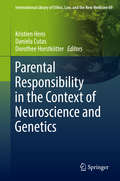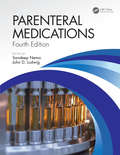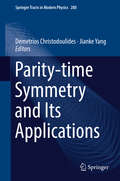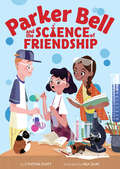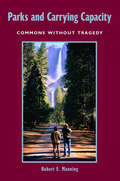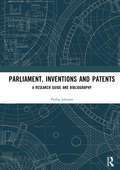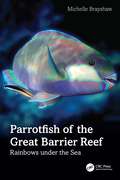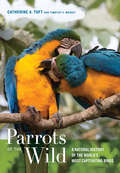- Table View
- List View
Parasitic Nematodes
by Mark Taylor Sarah Williams-Blangero Jonathan Ewbank David Knox Sara Lustigman Bernadette Connolly Susanne Hartmann Marie-Noëlle Rosso Joel Weinstock Aaron Maule Judith Allen Tony Page David Artis Rupert Quinnell Richard Grencis Malcolm Kennedy Rick Maizels Peter Hotez Roger Prichard Collette Britton Ralf Sommer John Gilleard Thomas Nutman David Bird Julian Hopkin William Harnett Mark VineyCovering a wide range of rapidly-developing fields of research into parasitic nematodes, this comprehensive volume discusses the genetics, biochemistry and immunology of nematode parasites of humans as well as domestic animals and plants. This fully-updated edition also covers new advances including horizontal gene transfer, immune expulsion mechanisms, genetics of susceptibility in humans, nematode protein structures, role of bacterial symbionts, intrinsic immune response, host immune system modulation, modulation of allergic and autoimmune diseases and the use of parasitic nematodes or their products as therapeutics.
Parasitic Nematodes: Molecular Biology, Biochemistry and Immunology
by Mark Taylor Sarah Williams-Blangero Jonathan Ewbank David Knox Sara Lustigman Bernadette Connolly Susanne Hartmann Marie-Noëlle Rosso Joel Weinstock Aaron Maule Judith Allen Tony Page David Artis Rupert Quinnell Richard Grencis Rick Maizels Peter Hotez Roger Prichard Collette Britton Ralf Sommer John Gilleard Thomas Nutman David Bird Julian Hopkin Mark VineyParasitic Nematodes are amongst the most successful parasites on Earth. This fully-updated second edition constitutes a comprehensive volume that continues to discuss the molecular biology, biochemistry and immunology of nematode parasites of humans, domestic animals and plants. There is a strong focus on new advances including chapters on horizontal gene transfer, genetics of susceptibility in humans, nematode protein structures, role of bacterial symbionts, host immune system modulation, modulation of allergic and autoimmune diseases by parasitic nematodes and the use of these organisms or their products as therapeutics. This book will be of significant importance to advanced students and researchers in human and veterinary parasitology, plant nematology and pathogen immunology in general.
Parasitic Orobanchaceae: Parasitic Mechanisms and Control Strategies
by Daniel M. Joel Jonathan Gressel Lytton J. MusselmanThis book was written in response to significant recent advances in understanding the mechanisms of parasitism in the Orobanchaceae, and breakthroughs in the control of the parasitic weeds Striga and Orobanche. It consists of 26 contributions by internationally recognized leading scientists. The main book chapters are grouped into two parts: · Part I - The Orobanchaceae and Their Parasitic Mechanisms · Part II - The Weedy Orobanchaceae and Their Control The first part provides cutting-edge information on all key aspects of plant parasitism, such as the structure, development and function of the haustorium; nutrient transfer and the physiology of the parasite-host association; host reaction to parasitic plants; seed production and germination; the strigolactones and host-parasite signaling mechanisms; the parasite genome, phylogenetics, evolution and epigenetics; and ecology. Topics of the second part include: the problem posed by the weedy parasites; population diversity and dynamics; molecular diagnosis of seed banks; and detailed discussion of the various management strategies, including agronomic, chemical and biotechnological approaches, as well as host breeding for resistance, allelopathy and biological control. This book is intended for plant scientists, university lecturers and students, agronomists and weed specialists, breeders and farmers, extension personnel and experts in tropical and subtropical agriculture.
Parasitic Plants in African Agriculture
by Professor Lytton John Musselman Dr Jonne RodenburgParasitic Plants in African Agriculture brings together for the first time in a single volume, the ecology, biology, damage, and control of all groups of African parasitic plants including both the relatively few parasites introduced to the continent as well as those native parasites that have spread from within Africa. The book covers the well-known witchweeds and broomrapes but also groups and species that have received less attention including mistletoes, dodders, rice vampire weed, and other species posing threats. The book distinguishes between stem and root parasitic weeds and between holoparasites and (facultative or obligate) hemiparasites. Based on their research and experience collectively spanning six decades, the authors provide an authoritative and state-of-the-art overview of the distribution, biology and impact of these highly specialized weeds and include recommendations for their management. Since parasitic plants in African agriculture primarily affect smallholder farmers, these weeds are explicitly discussed within a context of resource limitations and global changes. Readers are informed on all parasitic plant species relevant to African agriculture and the impact these plants have on crop production and livelihoods of smallholders in a changing world. Current and future management strategies are outlined in terms of their principles and effectiveness as well as their feasibility and affordability for farmers, all of which determine farmer adoption. The final chapter synthesises some of the relevant findings and statistics regarding parasitic weed distribution and their host crops and discusses implications in terms of future crop protection concerns in African agricultural systems. Key features: · Authoritative text based on extensive field and laboratory work. · First comprehensive state-of-the-art overview of parasitic plants and their management in Africa. · Highly illustrated with photos, graphs and species distribution maps. · Reviews previous basic and applied work, with relevance to smallholder farming systems. This book will be a valuable reference for students, researchers, extension workers, development officers, national agriculture researchers, plant pathologists, food security specialists, weed scientists, agronomists and botanists.
Parasitic Worms Of Fish
by Hartford WilliamsFish are a unique group which harbour some 30,000 species of helminths that do not occur in other vertebrates. This book deals specifically with parasitic worms of fish. It covers every aspect of their biology including identification, life-cycles, hostparasite relationships and ecology. It discusses approaches to studying parasitic worm infections, preference of species for particular host species, preference for dwelling in certain organs and tissues, biogeography, seasonality of infections and how parasites have evolved in parallel with their hosts. The book concludes with discussions of fish worms causing diseases in nature and in fish-farms.
Parasitic Zoonoses
by Prayag Dutt Juyal B.B.Singh DhaliwalThe book "Parasitic Zoonoses" emphasizes a veterinary and public health perspective of zoonotic parasites. This book is suitable for higher undergraduate and graduate students of zoonoses and public health, veterinary parasitology, parasite epidemiology; public health workers; public health veterinarians; field veterinarians, medical professionals and all others interested in the subject. More than 15 protozoa and 50 other parasitic diseases are zoonotic in nature and all these diseases have been discussed in detail. The first chapter is concerned with classification of zoonotic parasites, food borne, vector borne and occupation related zoonotic parasites. The remaining chapters cover etiology, epidemiology, life cycle, transmission, clinical signs, diagnosis, prevention and control of zoonotic parasites. The text is illustrated with a large number of coloured figures. An alphabetical bibliography for every disease has also been included so that readers have access to further information.
Parasitism
by Timothy M. Goater Cameron P. Goater Gerald W. Esch Timothy M. Goater Cameron P. GoaterAlmost all living organisms are exploited by parasites of one type or another. But what are parasites? How many different types are there? And what exactly is parasitism? In this undergraduate textbook parasitism is described as an ecological relationship. Ecology implies the study of the interaction between organisms and their environments and the fact that parasites' hosts are alive makes this concept even more exciting, combining traditionally disparate disciplines such as immunology and physiology with ecology and epidemiology! All the major groups of animal parasites are described, who they are and how they live. Also examined are their biogeography, evolution, and the way they influence the populations of their hosts and the immunological, pathological and biochemical implications of parasites. Written in an accessible style, the subject matter is brought to life with numerous illustrations and textboxes containing anecdotal, interesting and supplementary material. Essential for all undergraduate students studying parasitology, Parasitism: The Ecology and Diversity of Animal Parasites will also be useful reading for graduates and researchers in zoology and ecology.
Parasitism and Host Behaviour
by C. J. Barnard J. M. BehnkeRecent ideas and experimental studies suggest that the relationship between parasitism and host behaviour has been a powerful shaping force in the evolution not only of behaviour patterns themselves but, through them, of morphology and population and community dynamics. This book brings together recent work across the disciplines of parasitology an
Parasitoid Population Biology
by Michael E. Hochberg and Anthony R. IvesExtraordinary in the diversity of their lifestyles, insect parasitoids have become extremely important study organisms in the field of population biology, and they are the most frequently used agents in the biological control of insect pests. This book presents the ideas of seventeen international specialists, providing the reader not only with an overview but also with lively discussions of the most salient questions pertaining to the field today and prescriptions for avenues of future research. After a general introduction, the book divides into three main sections: population dynamics, population diversity, and population applications. The first section covers gaps in our knowledge in parasitoid behavior, parasitoid persistence, and how space and landscape affect dynamics. The contributions on population diversity consider how evolution has molded parasitoid populations and communities. The final section calls for novel approaches toward resolving the enigma of success in biological control and questions why parasitoids have been largely neglected in conservation biology. Parasitoid Population Biology will likely be an important influence on research well into the twenty-first century and will provoke discussion amongst parasitoid biologists and population biologists. In addition to the editors, the contributors are Carlos Bernstein, Jacques Brodeur, Jerome Casas, H.C.J. Godfray, Susan Harrison, Alan Hastings, Bradford A. Hawkins, George E. Heimpel, Marcel Holyoak, Nick Mills, Bernard D. Roitberg, Jens Roland, Michael R. Strand, Teja Tscharntke, and Minus van Baalen.
Parasitoid Wasps of South East Asia
by Dr Buntika A Butcher Dr Donald QuickeParasitoid wasps are cosmopolitan, numerous and enormously diverse with probably one million or more species worldwide, most of which occur in the moist tropics. Their ecological importance is enormous although perhaps most evident in their major roles in the control of insect pest populations. In natural ecosystems they are integral in regulating populations of a vast number of insects, and therefore are key players in terrestrial food webs. Knowledge of their biology is still very poor because the current state of taxonomy is still in its infancy in most parts of the world. In this book, we provide an overview of the more than 30 families of parasitoid wasps that occur in the 11 countries in South East Asia. Particular emphasis is given to those most commonly encountered and reared, as well as to those used in biological control programmes. Outlines of the morphology, biology, ecology and behaviour of each family, as well as of various important subfamilies are presented. The current state of taxonomy in the region is summarised. Other chapters cover basic biology, behaviour, morphological terminology, phylogeny and methods of specimen collecting, preparation and rearing with particular relevance to the tropics. Modern molecular approaches to speeding taxonomic description of hyperdiverse taxa are considered in depth. All groups are illustrated with colour photographs. This book will be of value to professional entomologists, academics, entomology students and the growing body of amateur entomologists and insect photographers.
Parasitoids in Pest Management
by OmkarPests cause economic damage to crops and stored products, while vectors are responsible for the transmission of disease-causing agents in human beings and livestock. Although the application of synthetic pesticides in agriculture has given immediate relief, it has also caused well-known side effects, leading to a general consensus among entomologists and agriculturists to shift towards other ecofriendly pest management. Insect natural enemies consisting of predators, parasitoids, and pathogens have attracted the attention of scientists across the globe. These natural enemies exist in agroecosystems and suppress the populations of pests. Parasitoids are farmers’ friends and the most successful group of natural enemies. Highly specialised in their host choice, the female parasitoid searches for a suitable host to lay eggs and larvae in, on or near the hosts. Exploiting this potency of parasitoids may yield successful results in controlling notorious pests in an ecofriendly way.This book covers information on the important biocontrol agents effective in pest suppression. It starts with insect parasitic groups followed by specific groups of parasitoids. It is hoped that the book presents a comprehensive account of beneficial parasitoirds, and will be useful to undergraduate and postgraduate students of Entomology, Biological Control, Plant Protection, Agricultural Zoology, and Zoology, besides those involved in competitive examinations and policy planning. Features: • Each chapter has been written by very experienced specialists.• Every chapter includes Learning Objectives and Points to Remember.• This book offers comprehensive knowledge of parasitoids and their application in pestmanagement in a rational way.
Parasitology
by Jack CherninParasitology provides all the basic principles of this increasingly studied subject, emphasised by specific, but important examples rather than covering organisms of just one particular group. It is ideally suited to the new modular/semester system now used by most universities and is laid out in the form of `notes' (rather than detailed descriptio
Parasitology: A Conceptual Approach
by Eric S. Loker Bruce V. HofkinProduced amidst the still rippling effects of a pandemic and as the world experiences the increasing burden of global warming and a rapidly changing biosphere, the second edition of Parasitology: A Conceptual Approach offers a timely overview of the eukaryotic parasites affecting human health and the health of domestic and wild animals and plants. The book offers a broadly encompassing, integrative view of the phenomenon of parasitism and of the remarkable diversity of the world’s parasites. This second edition has been thoroughly updated on all aspects of parasitism, including expanded sections on parasite biodiversity, parasite genomes, the interface between parasitology and disease ecology, and applications of new techniques like CRISPR and gene drives for parasite control. Key selling features: Emphasis on a distinctive integrative and conceptual approach rather than the taxon-by-taxon approach used in most parasitology books A concise, handy Rogues Gallery section that summarizes the basic biology for the most important eukaryotic parasites of humans and domestic animals, one a reader is repeatedly directed to throughout the chapters Outstanding full-color illustrations and photographs to reinforce key points The use of text boxes to set apart important topics or ideas that deserve special emphasis Provision of end-of-chapter summaries, questions to test understanding and key references for those wishing to seek further information Reference to particular URLs to highlight recent developments that often pose new and distinctive problems awaiting solution Parasitology: A Conceptual Approach is designed for an upper-level undergraduate audience, but its readability and careful explanation of underlying scientific concepts and terminology makes it appropriate for anyone seeking a broader understanding of the impact of infectious organisms on our well-being and the changes underway in the modern world.
Parasitology: An Integrated Approach (New York Academy of Sciences)
by Alan Gunn Sarah J. PittParasitology Highly detailed textbook on parasites and parasite relationships The fully revised edition of Parasitology: An Integrated Approach holds true to its engaging and easy-to-read approach. It comprehensively covers the complex and dynamic interaction between the parasite and its host ranging from invertebrates to vertebrates. Following an integrated approach, the authors explain how the study of parasites requires an understanding of biological concepts such as growth and reproduction, molecular biology, biochemistry, immunology, and pathology. In this second edition, they further address parasites and parasite relationships in the grand scheme of global changes and their impact. This textbook also reviews the often-neglected positive aspects of parasite infections and how humans have used parasites for their own advantage. Parasitology: An Integrated Approach, 2nd edition includes supplementary learning resources such as self-assessment quizzes, practical exercises, and an extensive collection of photographs. Now includes parasite life cycles in colour Strong focus on parasite interactions with other pathogens such as bacteria and viruses Discusses major advancements in the field of parasite diagnostics Additional image material and learning resources (quizzes, practical exercises) provided online A valuable and comprehensive learning resource for undergraduate students in the biological, biomedical and veterinary sciences and in medicine. It is also of interest to postgraduates and professionals with an interest including but not limited to parasitology, animal welfare, ecology, and medical microbiology.
Paratexts: Thresholds of Interpretation
by Gérard GenetteParatexts are those liminal devices and conventions, both within and outside the book, that mediate between book, author and reader: titles, forewords and publishers' jacket copy form part of a book's private and public history. In this first English translation of Paratexts, Gérard Genette offers a global view of these liminal mediations and their relation to the reading public. With precision, clarity and through wide reference, he shows how paratexts interact with general questions of literature as a cultural institution. Richard Macksey's foreword situates Genette in contemporary literary theory.
Parched - The Cape Town Drought Story
by Gisela KaiserThe book presents the history of water supply to Cape Town, leading up to the worst ever drought recorded, through political turmoil impacting on drought interventions and resulting in the adoption of an integrated water strategy.Regions reliant on water supply from rainfed dams have always been vulnerable to the impact of drought. This is exacerbated by the uncertainty of future rainfall, which is never guaranteed, and reliance is placed on modelling using historic data. While weather has always been variable, climate has been generally reliable. With anthropogenic activity causing changes in climate, the validity of modelling based on history is currently not fully trusted. Unless the storage capacity is sufficient to carry through numerous seasons of poor rainfall, even with water restrictions to match demand and supply in times of depleted rainfall, the risk of reservoirs running dry remains a threat.
Parent Nation: Unlocking Every Child's Potential, Fulfilling Society's Promise
by Dana SuskindWorld-class pediatric surgeon, social scientist, and best-selling author of Thirty Million Words Dr. Dana Suskind returns with a revelatory new look at the neuroscience of early childhood development—and how it can guide us toward a future in which every child has the opportunity to fulfill their potential.Her prescription for this more prosperous and equitable future, as clear as it is powerful, is more robust support for parents during the most critical years of their children&’s development. In her poignant new book, Parent Nation, written with award-winning science writer Lydia Denworth, Dr. Suskind helps parents recognize both their collective identity and their formidable power as custodians of our next generation. Weaving together the latest science on the developing brain with heart-breaking and relatable stories of families from all walks of life, Dr. Suskind shows that the status quo—scores of parents convinced they should be able to shoulder the enormous responsibility of early childhood care and education on their own—is not only unsustainable, but deeply detrimental to the wellbeing of children, families, and society. Anyone looking for a blueprint for how to build a brighter future for our children will find one in Parent Nation. Informed by the science of foundational brain development as well as history, political science, and the lived experiences of families around the country, this book clearly outlines how society can and should help families meet the developmental needs of their children. Only then can we ensure that all children are able to enjoy the promise of their potential.
Parental Responsibility in the Context of Neuroscience and Genetics
by Daniela Cutas Kristien Hens Dorothee HorstkötterShould parents aim to make their children as normal as possible to increase their chances to "fit in"? Are neurological and mental health conditions a part of children's identity and if so, should parents aim to remove or treat these? Should they aim to instill self-control in their children? Should prospective parents take steps to insure that, of all the children they could have, they choose the ones with the best likely start in life? This volume explores all of these questions and more. Against the background of recent findings and expected advances in neuroscience and genetics, the extent and limits of parental responsibility are increasingly unclear. Awareness of the effects of parental choices on children's wellbeing, as well as evolving norms about the moral status of children, have further increased expectations from (prospective) parents to take up and act on their changing responsibilities. The contributors discuss conceptual issues such as the meaning and sources of moral responsibility, normality, treatment, and identity. They also explore more practical issues such as how responsibility for children is practiced in Yoruba culture in Nigeria or how parents and health professionals in Belgium perceive the dilemmas generated by prenatal diagnosis.
Parenteral Medications, Fourth Edition
by Sandeep Nema John D. LudwigParenteral Medications is an authoritative, comprehensive reference work on the formulation and manufacturing of parenteral dosage forms, effectively balancing theoretical considerations with practical aspects of their development. Previously published as a three-volume set, all volumes have been combined into one comprehensive publication that addresses the plethora of changes in the science and considerable advances in the technology associated with these products and routes of administration. Key Features: Provides a comprehensive reference work on the formulation and manufacturing of parenteral dosage forms Addresses changes in the science and advances in the technology associated with parenteral medications and routes of administration Includes 13 new chapters and updated chapters throughout Contains the contributors of leading researchers in the field of parenteral medications Uses full color detailed illustrations, enhancing the learning process The fourth edition not only reflects enhanced content in all the chapters but also highlights the rapidly advancing formulation, processing, manufacturing parenteral technology including advanced delivery and cell therapies. The book is divided into seven sectionss: Section 1 - Parenteral Drug Administration and Delivery Devices; Section 2 - Formulation Design and Development; Section 3 - Specialized Drug Delivery Systems; Section 4 - Primary Packaging and Container Closure Integrity; Section 5 - Facility Design and Environmental Control; Section 6 - Sterilization and Pharmaceutical Processing; Section 7 - Quality Testing and Regulatory Requirements
Parity-time Symmetry and Its Applications (Springer Tracts in Modern Physics #280)
by Demetrios Christodoulides Jianke YangThis book offers a comprehensive review of the state-of-the-art theoretical and experimental advances in linear and nonlinear parity-time-symmetric systems in various physical disciplines, and surveys the emerging applications of parity-time (PT) symmetry. PT symmetry originates from quantum mechanics, where if the Schrodinger operator satisfies the PT symmetry, then its spectrum can be all real. This concept was later introduced into optics, Bose-Einstein condensates, metamaterials, electric circuits, acoustics, mechanical systems and many other fields, where a judicious balancing of gain and loss constitutes a PT-symmetric system. Even though these systems are dissipative, they exhibit many signature properties of conservative systems, which make them mathematically and physically intriguing. Important PT-symmetry applications have also emerged. This book describes the latest advances of PT symmetry in a wide range of physical areas, with contributions from the leading experts. It is intended for researchers and graduate students to enter this research frontier, or use it as a reference book.
Parker Bell and the Science of Friendship
by Cynthia PlattIn this fun young-middle-grade novel with STEM appeal, Parker really wants to win the school Science Triathlon—but first she’ll have to figure out how to keep her BFF from being stolen.Budding scientist Parker Bell really wants to win the school Science Triathlon and follow in the footsteps of her idols, chimpanzee expert Jane Goodall and astronaut Mae Jemison. She’s sure that if she teams up with her trivia whiz BFF, Cassie, they will dominate the Science Bee, Egg Drop, and Animal Adaptation Presentation. When Cassie invites her new friend, Theo, to join their team, Parker is worried—that Theo won't help them win and might steal her best friend. As the three work together, Parker learns that you don’t have to be the best to be a real scientist and a good friend.
Parks and Carrying Capacity: Commons Without Tragedy
by Robert E. ManningHow much can we use the environment without spoiling what we find so valuable about it? Determining the carrying capacity of parks and related areas is a perennial question whose urgency grows each year as the number of visits continues to increase. Parks and Carrying Capacity represents a comprehensive assessment of the issue, as it:* offers a historical and conceptual treatment ofcarrying capacity* describes and illustrates research approaches forassessing carrying capacity, including qualitative and quantitativesurveys, normative theory and methods, visual research approaches,trade-off analysis, and simulation modeling* examines management alternatives for limiting the environmentaland social impacts of visitor use* considers the broader question of environmental management andhow the issue of carrying capacity can be applied more generally* discusses how the theory and methods associated with managingthe carrying capacity of parks and protected areas might be extendedto other areas of environmental managementThe book includes a series of case studies that describe research programsdesigned to support analysis and management of carrying capacity at eight diverse units of the U.S. National Park System, and an additional case study that explores how the foundational components of carrying capacity (formulating indicators and standards, monitoring, and adaptive management) are being applied in an increasing number of environmental and natural resources fields to address the growing urgency of sustainability. Parks and Carrying Capacity is an important new work for faculty, graduate and undergraduate students, and researchers in outdoor recreation, park planning and management, and natural resource conservation and management, as well as for professional planners and managers involved with park and outdoor recreation related agencies and nongovernmental organizations.
Parliament, Inventions and Patents: A Research Guide and Bibliography
by Phillip JohnsonThis book is a research guide and bibliography of Parliamentary material, including the Old Scottish Parliament and the Old Irish Parliament, relating to patents and inventions from the early seventeenth century to 1976. It chronicles the entire history of a purely British patent law before the coming into force of the European Patent Convention under the Patents Act 1977. It provides a comprehensive record of every Act, Bill, Parliamentary paper, report, petition and recorded debate or Parliamentary question on patent law during the period. The work will be an essential resource for scholars and researchers in intellectual property law, the history of technology, and legal and economic history.
Parrotfish of the Great Barrier Reef: Rainbows under the Sea
by Michelle BrayshawThe array of colours found on the Scarini tribe (family: Labridae), commonly known as the Parrotfish, is truly astounding and is showcased to breathtaking effect in this book. Photographer and artist Michelle Brayshaw reveals the array of colour changes which these fish display through ontological (slow) and physiological (fast) processes. The obvious differences occur in the three phases of their lives, but it is the subtle changes in colour that can be the most bizarre, occurring while feeding, mating, courting, cleaning, camouflaging themselves to their backgrounds or the fish around them, experiencing mood swings, fighting, playing and, most excitingly of all, when they are transitioning from female to male. This feat is not unique to the Parrotfish, but no other animals do it with such glamour and colour.Through hundreds of hours of observational research, this book highlights the light play and physiological and ontological colour changes of the Scarini found on the Great Barrier Reef in stunning photographic accuracy. It also includes comprehensive information about why Parrotfish are so important for the health and resilience of the reef,f instilling in the reader a deeper sense of the treasures found there and reminding us of the interconnected nature of our existence.
Parrots of the Wild
by Timothy F. Wright Catherine A. ToftParrots of the Wild explores recent scientific discoveries and what they reveal about the lives of wild parrots, which are among the most intelligent and rarest of birds. Catherine A. Toft and Tim Wright discuss the evolutionary history of parrots and how this history affects perceptual and cognitive abilities, diet and foraging patterns, and mating and social behavior. The authors also discuss conservation status and the various ways different populations are adapting to a world that is rapidly changing. The book focuses on general patterns across the 350-odd species of parrots, as well as what can be learned from interesting exceptions to these generalities. A synthetic account of the diversity and ecology of wild parrots, this book distills knowledge from the authors' own research and from their review of more than 2,400 published scientific studies. The book is enhanced by an array of illustrations, including nearly ninety color photos of wild parrots represented in their natural habitats. Parrots of the Wild melds scientific exploration with features directed at the parrot enthusiast to inform and delight a broad audience.
